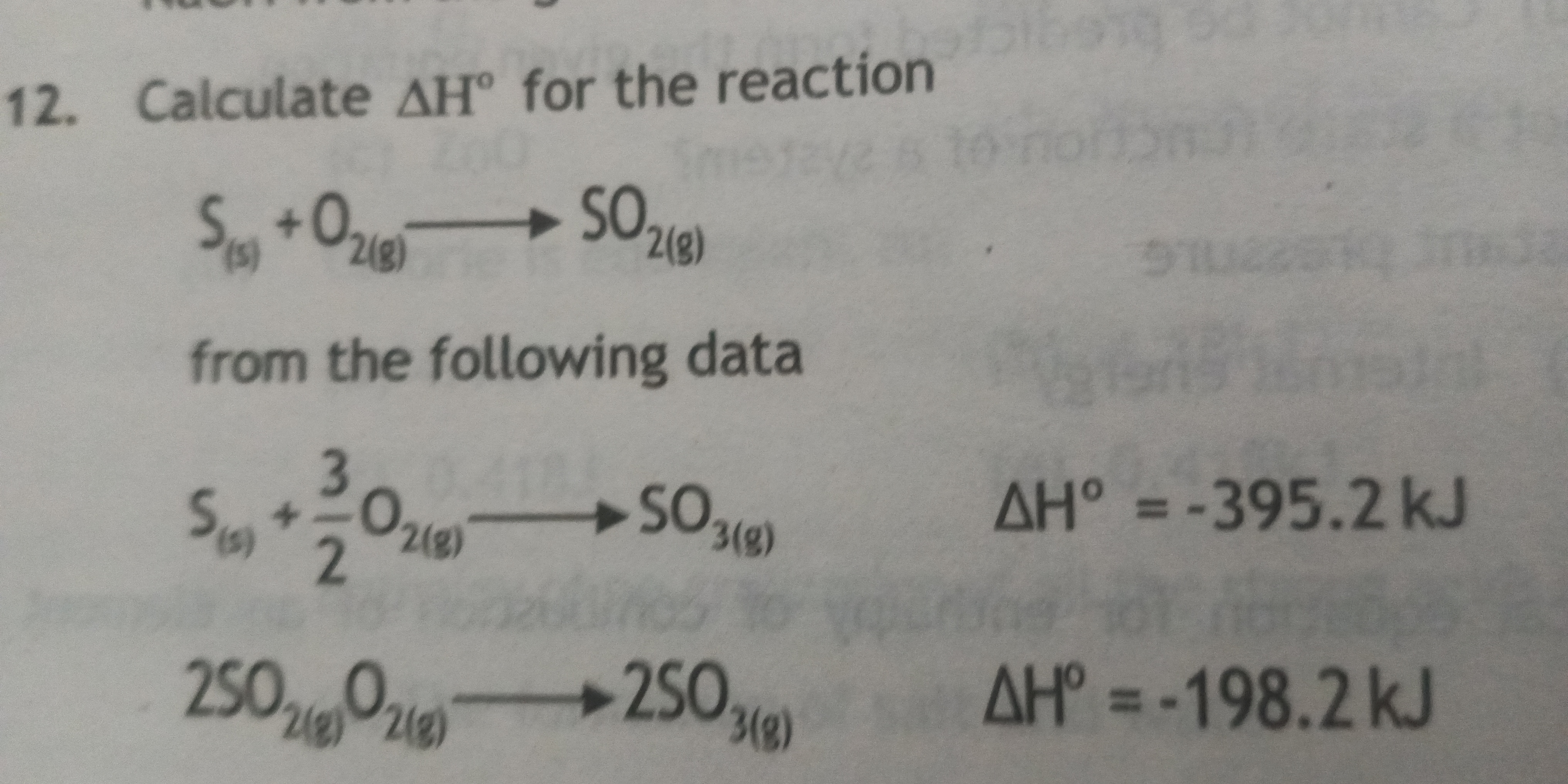Calculate ΔH° for the reaction S(s) + O2(g) → SO2(g) from the following data: S(s) + (3/2)O2(g) → SO3(g) ΔH° = -395.2 kJ 2SO2(g) + O2(g) → 2SO3(g) ΔH° = -198.2 kJ

Understand the Problem
The question asks to calculate the standard enthalpy change (ΔH°) for the reaction S(s) + O2(g) → SO2(g) using the provided thermochemical data for the formation of SO3(g) and the conversion of SO2(g) to SO3(g). This problem will require applying Hess's Law to manipulate and combine the given reactions to obtain the target reaction and calculate its ΔH°.
Answer
$ΔH° = -296.1 \text{ kJ}$
Answer for screen readers
$ΔH° = -296.1 \text{ kJ}$
Steps to Solve
- Write down the target reaction and the given reactions
Target reaction: $S_{(s)} + O_{2(g)} \rightarrow SO_{2(g)}$
Given reactions: $S_{(s)} + \frac{3}{2}O_{2(g)} \rightarrow SO_{3(g)} \quad ΔH°1 = -395.2 \text{ kJ}$ $2SO{2(g)} + O_{2(g)} \rightarrow 2SO_{3(g)} \quad ΔH°_2 = -198.2 \text{ kJ}$
- Manipulate the second reaction
We need $SO_2$ on the product side, so reverse the second reaction and divide it by 2:
$2SO_{3(g)} \rightarrow 2SO_{2(g)} + O_{2(g)} \quad -ΔH°2 = +198.2 \text{ kJ}$ $SO{3(g)} \rightarrow SO_{2(g)} + \frac{1}{2}O_{2(g)} \quad -\frac{ΔH°_2}{2} = \frac{198.2}{2} = 99.1 \text{ kJ}$
- Add the first reaction and the modified second reaction
Adding the first reaction and the reverse of the second reaction (divided by 2):
$S_{(s)} + \frac{3}{2}O_{2(g)} \rightarrow SO_{3(g)} \quad ΔH°1 = -395.2 \text{ kJ}$ $SO{3(g)} \rightarrow SO_{2(g)} + \frac{1}{2}O_{2(g)} \quad -\frac{ΔH°2}{2} = 99.1 \text{ kJ}$ Adding the two reactions together gives: $S{(s)} + \frac{3}{2}O_{2(g)} + SO_{3(g)} \rightarrow SO_{3(g)} + SO_{2(g)} + \frac{1}{2}O_{2(g)}$
- Simplify the equation
Canceling out $SO_3(g)$ from both sides:
$S_{(s)} + \frac{3}{2}O_{2(g)} \rightarrow SO_{2(g)} + \frac{1}{2}O_{2(g)}$ $S_{(s)} + (\frac{3}{2} - \frac{1}{2})O_{2(g)} \rightarrow SO_{2(g)}$ $S_{(s)} + O_{2(g)} \rightarrow SO_{2(g)}$
- Calculate the overall ΔH°
Adding the enthalpies of the reactions:
$ΔH° = ΔH°_1 + (-\frac{ΔH°_2}{2}) = -395.2 + 99.1 = -296.1 \text{ kJ}$
$ΔH° = -296.1 \text{ kJ}$
More Information
The standard enthalpy change, $ΔH°$, represents the change in enthalpy for a reaction carried out under standard conditions. In this case, it's the heat absorbed or released when one mole of $SO_2$ is formed from its elements in their standard states.
Tips
A common mistake is forgetting to reverse the sign of $ΔH°$ when reversing a reaction. Also, not dividing the second reaction by 2 before summing it with the first reaction. Another mistake would be failing to cancel the $SO_3(g)$
AI-generated content may contain errors. Please verify critical information